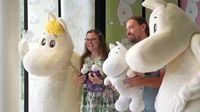Finland’s most cherished literary family, the Moomins, have reached a rare milestone in 2025: their 80th birthday. These hippopotamus-like creatures, first sketched into life by author and illustrator Tove Jansson in 1945, have since become a global phenomenon, charming generations from Helsinki to Tokyo. The anniversary has sparked a wave of nostalgia, celebration, and reflection on the enduring magic of Moominvalley—and the progressive, quietly radical ideas that have always bubbled beneath its whimsical surface.
The Moomins made their literary debut in The Moomins and the Great Flood, published in the waning days of World War II. Jansson, a Swedish-speaking Finn who passed away in 2001, introduced readers to Moomintroll and Moominmamma as they searched for the missing Moominpappa, setting the tone for tales that would blend escapism with undertones of real-world struggle. Over the next decades, Jansson would pen eight more novels, a slew of picture books, and a long-running comic strip in Swedish. The stories, set in the idyllic yet unpredictable Moominvalley, have since been translated into more than 60 languages—a testament to their universal appeal, according to the BBC.
The global reach of the Moomins is hard to overstate. Their adventures have inspired film and television adaptations, children’s plays, art gallery exhibitions, and even a dedicated Moomin Museum in Tampere, southern Finland. For those seeking a more immersive experience, Moomin theme parks now operate in both Finland and Japan, while Finnish national airline Finnair has adorned its aircraft with Moomin imagery, bringing a dash of Moominvalley to the skies.
This year’s 80th anniversary has been marked by a flurry of festivities, with fans converging on Tampere—the home of the Moomin Museum—on August 9 to honor both the 1945 publication and Jansson’s birthday. The celebrations drew devotees from around the world, many of whom have carried their love of the Moomins from childhood well into adulthood.
Rosa Senn, a fan from the United Kingdom, described the Moomins as a lifelong source of comfort and connection. “Moomins have been such a special thing in my life, my whole life,” Senn told the Associated Press. “I just carried that love for Moomin, for Tove Jansson, with me into my adult life.” The stories became even more meaningful when Senn met her now-wife, Lizzie. During the early, long-distance phase of their relationship, the couple used a plush Moomintroll doll to bridge the gap between them. The doll later served as the ringbearer at their wedding and accompanied them on their honeymoon to Tampere. Their shared adventures, documented on Instagram, have attracted nearly 11,000 followers and connected them with Moomin fans worldwide—including Stefanie and Michael Geutebrück from Germany.
For Stefanie Geutebrück, the Moomins were a childhood staple, thanks to animated adaptations she watched growing up in East Germany. She introduced her husband to the world of Moominvalley, and together they made the pilgrimage to Tampere for this year’s celebrations. “Now he’s a total fan and our apartment looks like a Moomin shop,” Stefanie laughed, as reported by the BBC.
That enthusiasm is mirrored in the booming global market for Moomin merchandise. From plush dolls to figurines and, most notably, the iconic Moomin mug, collectors snap up souvenirs featuring not just the main trio—Moomintroll, Moominmamma, and Moominpappa—but also beloved secondary characters like Snufkin, Snork Maiden, and the mischievous Stinky. “The Moomin mug is one of the best-known collector items worldwide,” Selma Green, director of the Moomin Museum, explained. “You buy a Moomin mug, you like the characters, you maybe see something on TV—but we all go back to the books, the original illustrations.”
Yet not all Moomin news this year has been celebratory. The character Stinky, a “lovable rogue” with a dark, fuzzy body and antennae, became the subject of heated debate after reports emerged that murals featuring him were removed from an exhibit at the Brooklyn Public Library in New York. The move, prompted by concerns that Stinky’s depiction could be perceived as racist, sparked outcry in Finland and among fans worldwide. According to Finnish media, Stinky is traditionally portrayed as an unsuccessful criminal whose schemes are always foiled—more mole or vole than villain, in the eyes of many. “To me, this became quite a big surprise because I have more thought about Stinky being close to a mole or a vole,” Sirke Happonen, a Moomins scholar and associate professor at the University of Helsinki, told the BBC. “He’s an interesting character in many ways, like controversial and fun.”
Perhaps part of the Moomins’ enduring resonance lies in their subtle, progressive sensibilities. Jansson’s stories honor the idea of family as a flexible, inclusive concept. Moominvalley is a place where diverse gender roles and queer themes are gently woven into the fabric of daily life—a reflection of Jansson’s own LGBTQ+ identity. Her partner of more than 45 years, engraver and artist Tuulikki Pietilä, was immortalized as the character Too-ticky in Moominland Midwinter. The couple lived together in Helsinki and spent their summers on the rocky island of Klovharu, surrounded by the quiet beauty of the Gulf of Finland.
Jansson’s writing was shaped by the turbulence of her times. The first Moomin book, The Moomins and the Great Flood, was published during the final months of World War II—a period of devastation for Finland, which, though it remained independent, was left battered by conflict. Jansson’s own brother went missing at the front for a time. Against this backdrop, the author sought to create a world that offered both comfort and complexity. “Her first Moomin book came out in a dark era. She felt it was very difficult to paint, and she started writing what she called a fairy tale, but she excused herself not to include princesses or princes,” Happonen told the Associated Press. Moominvalley, she explained, was born from “a need to find beauty at a time when Jansson’s existence, along with everyone else in Finland, felt frail.”
“I think she wanted to make a contrast—Tove Jansson loved contrasts—by writing about this beautiful world, full of friendship and love,” Happonen added, highlighting the delicate balance of peril and comfort that defines the Moomin tales.
As the Moomins celebrate 80 years, their legacy feels more vital than ever. Whether offering solace during uncertain times or championing the quiet joys of chosen family and acceptance, Moominvalley remains a place where readers of all ages—and from every corner of the globe—can feel at home.


